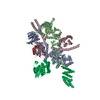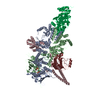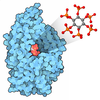+ Open data
Open data
- Basic information
Basic information
| Entry | Database: PDB / ID: 7zr5 | ||||||||||||||||||||||||||||||||||||||||||||||||||||||
|---|---|---|---|---|---|---|---|---|---|---|---|---|---|---|---|---|---|---|---|---|---|---|---|---|---|---|---|---|---|---|---|---|---|---|---|---|---|---|---|---|---|---|---|---|---|---|---|---|---|---|---|---|---|---|---|
| Title | CryoEM structure of HSP90-CDC37-BRAF(V600E)-PP5(closed) complex | ||||||||||||||||||||||||||||||||||||||||||||||||||||||
 Components Components |
| ||||||||||||||||||||||||||||||||||||||||||||||||||||||
 Keywords Keywords | PROTEIN BINDING / Complex | ||||||||||||||||||||||||||||||||||||||||||||||||||||||
| Function / homology |  Function and homology information Function and homology informationregulation of type II interferon-mediated signaling pathway / positive regulation of nuclear receptor-mediated glucocorticoid signaling pathway / peptidyl-serine dephosphorylation / response to arachidonate / HSP90-CDC37 chaperone complex / peptidyl-threonine dephosphorylation / negative regulation of proteasomal protein catabolic process / Aryl hydrocarbon receptor signalling / aryl hydrocarbon receptor complex / positive regulation of axon regeneration ...regulation of type II interferon-mediated signaling pathway / positive regulation of nuclear receptor-mediated glucocorticoid signaling pathway / peptidyl-serine dephosphorylation / response to arachidonate / HSP90-CDC37 chaperone complex / peptidyl-threonine dephosphorylation / negative regulation of proteasomal protein catabolic process / Aryl hydrocarbon receptor signalling / aryl hydrocarbon receptor complex / positive regulation of axon regeneration / histone methyltransferase binding / CD4-positive, alpha-beta T cell differentiation / dynein axonemal particle / CD4-positive or CD8-positive, alpha-beta T cell lineage commitment / negative regulation of synaptic vesicle exocytosis / receptor ligand inhibitor activity / Signalling to p38 via RIT and RIN / proximal dendrite / head morphogenesis / positive regulation of type 2 mitophagy / ARMS-mediated activation / endothelial cell apoptotic process / myeloid progenitor cell differentiation / SHOC2 M1731 mutant abolishes MRAS complex function / Gain-of-function MRAS complexes activate RAF signaling / regulation of cyclin-dependent protein serine/threonine kinase activity / positive regulation of D-glucose transmembrane transport / protein kinase regulator activity / negative regulation of fibroblast migration / ATP-dependent protein binding / positive regulation of protein localization to cell surface / establishment of protein localization to membrane / positive regulation of axonogenesis / mitogen-activated protein kinase kinase kinase binding / protein folding chaperone complex / regulation of T cell differentiation / Negative feedback regulation of MAPK pathway / response to morphine / Frs2-mediated activation / post-transcriptional regulation of gene expression / protein-serine/threonine phosphatase / stress fiber assembly / Respiratory syncytial virus genome replication / telomerase holoenzyme complex assembly / Uptake and function of diphtheria toxin / positive regulation of transforming growth factor beta receptor signaling pathway / Drug-mediated inhibition of ERBB2 signaling / Resistance of ERBB2 KD mutants to trastuzumab / Resistance of ERBB2 KD mutants to sapitinib / Resistance of ERBB2 KD mutants to tesevatinib / Resistance of ERBB2 KD mutants to neratinib / Resistance of ERBB2 KD mutants to osimertinib / Resistance of ERBB2 KD mutants to afatinib / Resistance of ERBB2 KD mutants to AEE788 / Resistance of ERBB2 KD mutants to lapatinib / Drug resistance in ERBB2 TMD/JMD mutants / regulation of type I interferon-mediated signaling pathway / dendritic growth cone / TPR domain binding / face development / cellular response to cadmium ion / protein serine/threonine phosphatase activity / MAP kinase kinase activity / Assembly and release of respiratory syncytial virus (RSV) virions / phosphatase activity / thyroid gland development / phosphoprotein phosphatase activity / The NLRP3 inflammasome / protein phosphatase activator activity / Sema3A PAK dependent Axon repulsion / synaptic vesicle exocytosis / somatic stem cell population maintenance / regulation of protein ubiquitination / positive regulation of peptidyl-serine phosphorylation / protein serine/threonine kinase inhibitor activity / G-protein alpha-subunit binding / HSF1-dependent transactivation / MAP kinase kinase kinase activity / response to unfolded protein / HSF1 activation / Attenuation phase / negative regulation of endothelial cell apoptotic process / chaperone-mediated protein complex assembly / RHOBTB2 GTPase cycle / protein targeting / telomere maintenance via telomerase / axonal growth cone / postsynaptic modulation of chemical synaptic transmission / protein dephosphorylation / Purinergic signaling in leishmaniasis infection / : / negative regulation of MAPK cascade / positive regulation of stress fiber assembly / DNA polymerase binding / heat shock protein binding / supramolecular fiber organization / ERK1 and ERK2 cascade / Signaling by ERBB2 / negative regulation of proteasomal ubiquitin-dependent protein catabolic process / positive regulation of substrate adhesion-dependent cell spreading Similarity search - Function | ||||||||||||||||||||||||||||||||||||||||||||||||||||||
| Biological species |  Homo sapiens (human) Homo sapiens (human) | ||||||||||||||||||||||||||||||||||||||||||||||||||||||
| Method | ELECTRON MICROSCOPY / single particle reconstruction / cryo EM / Resolution: 3.9 Å | ||||||||||||||||||||||||||||||||||||||||||||||||||||||
 Authors Authors | Oberoi, J. / Pearl, L.H. | ||||||||||||||||||||||||||||||||||||||||||||||||||||||
| Funding support |  United Kingdom, 1items United Kingdom, 1items
| ||||||||||||||||||||||||||||||||||||||||||||||||||||||
 Citation Citation |  Journal: Nat Commun / Year: 2022 Journal: Nat Commun / Year: 2022Title: HSP90-CDC37-PP5 forms a structural platform for kinase dephosphorylation. Authors: Jasmeen Oberoi / Xavi Aran Guiu / Emily A Outwin / Pascale Schellenberger / Theodoros I Roumeliotis / Jyoti S Choudhary / Laurence H Pearl /  Abstract: Activation of client protein kinases by the HSP90 molecular chaperone system is affected by phosphorylation at multiple sites on HSP90, the kinase-specific co-chaperone CDC37, and the kinase client ...Activation of client protein kinases by the HSP90 molecular chaperone system is affected by phosphorylation at multiple sites on HSP90, the kinase-specific co-chaperone CDC37, and the kinase client itself. Removal of regulatory phosphorylation from client kinases and their release from the HSP90-CDC37 system depends on the Ser/Thr phosphatase PP5, which associates with HSP90 via its N-terminal TPR domain. Here, we present the cryoEM structure of the oncogenic protein kinase client BRAF bound to HSP90-CDC37, showing how the V600E mutation favours BRAF association with HSP90-CDC37. Structures of HSP90-CDC37-BRAF complexes with PP5 in autoinhibited and activated conformations, together with proteomic analysis of its phosphatase activity on BRAF and CRAF, reveal how PP5 is activated by recruitment to HSP90 complexes. PP5 comprehensively dephosphorylates client proteins, removing interaction sites for regulatory partners such as 14-3-3 proteins and thus performing a 'factory reset' of the kinase prior to release. | ||||||||||||||||||||||||||||||||||||||||||||||||||||||
| History |
|
- Structure visualization
Structure visualization
| Structure viewer | Molecule:  Molmil Molmil Jmol/JSmol Jmol/JSmol |
|---|
- Downloads & links
Downloads & links
- Download
Download
| PDBx/mmCIF format |  7zr5.cif.gz 7zr5.cif.gz | 417.7 KB | Display |  PDBx/mmCIF format PDBx/mmCIF format |
|---|---|---|---|---|
| PDB format |  pdb7zr5.ent.gz pdb7zr5.ent.gz | 322.2 KB | Display |  PDB format PDB format |
| PDBx/mmJSON format |  7zr5.json.gz 7zr5.json.gz | Tree view |  PDBx/mmJSON format PDBx/mmJSON format | |
| Others |  Other downloads Other downloads |
-Validation report
| Summary document |  7zr5_validation.pdf.gz 7zr5_validation.pdf.gz | 1.3 MB | Display |  wwPDB validaton report wwPDB validaton report |
|---|---|---|---|---|
| Full document |  7zr5_full_validation.pdf.gz 7zr5_full_validation.pdf.gz | 1.4 MB | Display | |
| Data in XML |  7zr5_validation.xml.gz 7zr5_validation.xml.gz | 72.6 KB | Display | |
| Data in CIF |  7zr5_validation.cif.gz 7zr5_validation.cif.gz | 110.6 KB | Display | |
| Arichive directory |  https://data.pdbj.org/pub/pdb/validation_reports/zr/7zr5 https://data.pdbj.org/pub/pdb/validation_reports/zr/7zr5 ftp://data.pdbj.org/pub/pdb/validation_reports/zr/7zr5 ftp://data.pdbj.org/pub/pdb/validation_reports/zr/7zr5 | HTTPS FTP |
-Related structure data
| Related structure data |  14883MC  7zr0C  7zr6C M: map data used to model this data C: citing same article ( |
|---|---|
| Similar structure data | Similarity search - Function & homology  F&H Search F&H Search |
- Links
Links
- Assembly
Assembly
| Deposited unit | 
|
|---|---|
| 1 |
|
- Components
Components
| #1: Protein | Mass: 86223.469 Da / Num. of mol.: 2 Source method: isolated from a genetically manipulated source Source: (gene. exp.)  Homo sapiens (human) / Gene: HSP90AB1, HSP90B, HSPC2, HSPCB / Production host: Homo sapiens (human) / Gene: HSP90AB1, HSP90B, HSPC2, HSPCB / Production host:  Spodoptera (butterflies/moths) / References: UniProt: P08238 Spodoptera (butterflies/moths) / References: UniProt: P08238#2: Protein | | Mass: 46853.816 Da / Num. of mol.: 1 Source method: isolated from a genetically manipulated source Source: (gene. exp.)  Homo sapiens (human) / Gene: CDC37, CDC37A / Production host: Homo sapiens (human) / Gene: CDC37, CDC37A / Production host:  Spodoptera (butterflies/moths) / References: UniProt: Q16543 Spodoptera (butterflies/moths) / References: UniProt: Q16543#3: Protein | | Mass: 90934.508 Da / Num. of mol.: 1 Source method: isolated from a genetically manipulated source Source: (gene. exp.)  Homo sapiens (human) / Gene: BRAF, BRAF1, RAFB1 / Production host: Homo sapiens (human) / Gene: BRAF, BRAF1, RAFB1 / Production host:  Spodoptera (butterflies/moths) Spodoptera (butterflies/moths)References: UniProt: P15056, non-specific serine/threonine protein kinase #4: Protein | | Mass: 56020.387 Da / Num. of mol.: 1 Source method: isolated from a genetically manipulated source Source: (gene. exp.)  Homo sapiens (human) / Gene: PPP5C, PPP5 / Production host: Homo sapiens (human) / Gene: PPP5C, PPP5 / Production host:  References: UniProt: P53041, protein-serine/threonine phosphatase #5: Chemical | Has ligand of interest | Y | Has protein modification | Y | |
|---|
-Experimental details
-Experiment
| Experiment | Method: ELECTRON MICROSCOPY |
|---|---|
| EM experiment | Aggregation state: PARTICLE / 3D reconstruction method: single particle reconstruction |
- Sample preparation
Sample preparation
| Component |
| ||||||||||||||||||||||||
|---|---|---|---|---|---|---|---|---|---|---|---|---|---|---|---|---|---|---|---|---|---|---|---|---|---|
| Source (natural) |
| ||||||||||||||||||||||||
| Source (recombinant) |
| ||||||||||||||||||||||||
| Buffer solution | pH: 7.5 | ||||||||||||||||||||||||
| Specimen | Embedding applied: NO / Shadowing applied: NO / Staining applied: NO / Vitrification applied: YES | ||||||||||||||||||||||||
| Vitrification | Cryogen name: ETHANE |
- Electron microscopy imaging
Electron microscopy imaging
| Experimental equipment |  Model: Titan Krios / Image courtesy: FEI Company |
|---|---|
| Microscopy | Model: FEI TITAN KRIOS |
| Electron gun | Electron source:  FIELD EMISSION GUN / Accelerating voltage: 300 kV / Illumination mode: FLOOD BEAM FIELD EMISSION GUN / Accelerating voltage: 300 kV / Illumination mode: FLOOD BEAM |
| Electron lens | Mode: BRIGHT FIELD / Nominal defocus max: 2500 nm / Nominal defocus min: 1300 nm |
| Image recording | Electron dose: 45 e/Å2 / Film or detector model: FEI FALCON IV (4k x 4k) |
- Processing
Processing
| Software | Name: PHENIX / Version: 1.20.1_4487: / Classification: refinement | ||||||||||||||||||||||||
|---|---|---|---|---|---|---|---|---|---|---|---|---|---|---|---|---|---|---|---|---|---|---|---|---|---|
| EM software |
| ||||||||||||||||||||||||
| CTF correction | Type: NONE | ||||||||||||||||||||||||
| 3D reconstruction | Resolution: 3.9 Å / Resolution method: FSC 0.143 CUT-OFF / Num. of particles: 105063 / Symmetry type: POINT | ||||||||||||||||||||||||
| Refine LS restraints |
|
 Movie
Movie Controller
Controller





 PDBj
PDBj





























